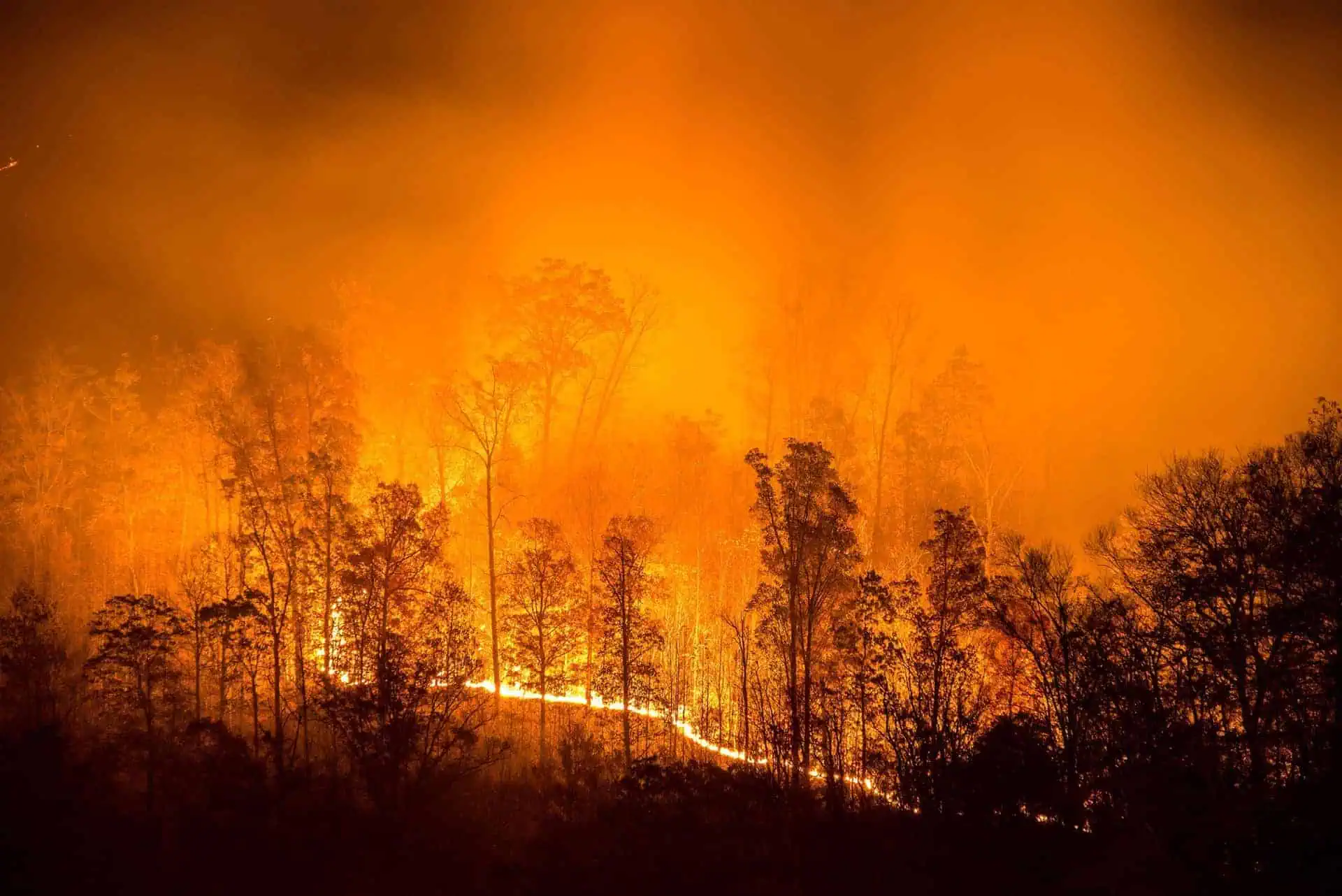FAQ: When Did The Maui Fires Start?
- Last Updated: July 14th, 2025

Attorney Jessica Paluch-Hoerman, founder of TruLaw, has over 28 years of experience as a personal injury and mass tort attorney, and previously worked as an international tax attorney at Deloitte. Jessie collaborates with attorneys nationwide — enabling her to share reliable, up-to-date legal information with our readers.
Legally Reviewed
This article has been written and reviewed for legal accuracy and clarity by the team of writers and legal experts at TruLaw and is as accurate as possible. This content should not be taken as legal advice from an attorney. If you would like to learn more about our owner and experienced injury lawyer, Jessie Paluch, you can do so here.
Fact-Checked
TruLaw does everything possible to make sure the information in this article is up to date and accurate. If you need specific legal advice about your case, contact us by using the chat on the bottom of this page. This article should not be taken as advice from an attorney.
Key takeaways:
- On August 8th, 2023, the Maui wildfires took hold, their origins traced back to an area of Lahaina.
- Exceptionally high winds coupled with tremendously dry conditions led to the rapid spread of the fires
- Within 24 hours, the fires had rapidly spread, consuming hundreds of acres in Kula and Olinda.
Overview of When Did The Maui Fires Start?
Question: When did the Maui fires start?
Answer: The Maui fires officially began on August 8th, 2023.
However, there were indications of a high risk of fire as early as August 4th, 2023, when brushfires were reported.
The situation escalated when sensors detected faults in the power grid near Makawao on the night of August 7th, 2023, and two major faults in the early hours of August 8th, 2023.
Intro to When Did The Maui Fires Start
The island of Maui faced a series of events leading up to the devastating wildfires of August 8th, 2023.
On August 4th, brushfires were reported, signaling a heightened risk of more extensive fires.
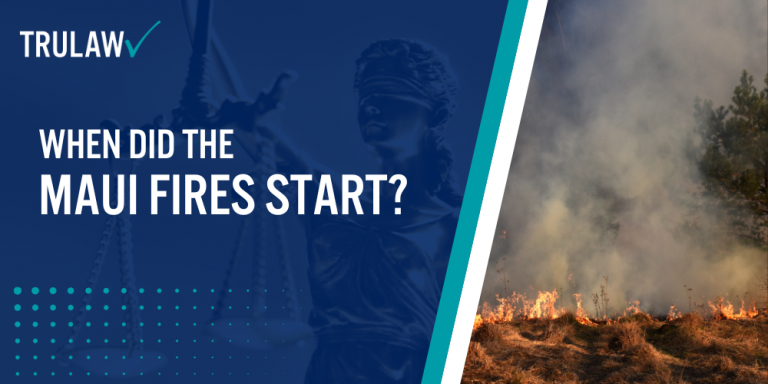
The situation became more alarming on the night of August 7th, when sensors detected a fault in the power grid near Makawao.
This was followed by two major faults detected by sensors between 2:44 A.M and 3:30 A.M. on August 8th.
The culmination of these events led to the rapid spread of wildfires across the island, especially affecting the historic town of Lahaina.
Emergency services were dispatched promptly, but the combination of prior brushfires, power grid faults, and challenging weather conditions made containment efforts extremely challenging.
Despite the immediate response from emergency personnel, the fire led to widespread destruction, affecting both the local ecosystem and infrastructure.
Table of Contents
Chronology of the Maui Fires
This timeline will help understand the sequence of events that led to the Maui County’s lawsuit against the Hawaiian Electric Company for alleged negligence.
The details provided herein are based on court documents from the Second Circuit Court case number 2CCV-23-0000238.
August 8th – The Triggering Event
On August 8th, the Maui wildfires took hold, their origins traced back to an area of Lahaina.
Exceptionally high winds coupled with tremendously dry conditions led to the rapid spread of the fires over a large expanse of land.
August 9th – Fires Spread to Kula and Olinda
Within 24 hours, the fires had rapidly spread, consuming hundreds of acres in Kula and Olinda.
The expansion of the fire was potentially boosted by the continued presence of wind and arid conditions.
Despite the worsening situation, the Hawaiian Electric Company remained operational throughout these areas.
August 10th-13th – Continued Burning and Devastation
Over the following days, the wildfires continued to rage, ultimately ravaging over 2,000 acres in Lahaina alone.
During this time, both public and private properties were greatly impacted, with many residents facing dangerous conditions and significant property loss.
Post August 14th – Aftermath and Legal Consequences
Once the fires were finally brought under control and extinguished, the extent of the damage was clear.
With over 2,000 acres of land in Lahaina and hundreds more in Kula and Olinda destroyed, local resources and public property suffered immensely.
In the aftermath of the fires, Maui County initiated a lawsuit against the Hawaiian Electric Company.
According to the allegations stated in the lawsuit, despite the clear and present danger posed by the high winds and dry conditions, the utility company failed to shut off the power.
This negligence, the lawsuit argues, contributed significantly to the severity and spread of the wildfires.
As a result of these fires, the County has incurred considerable expense in terms of firefighting efforts, rehabilitation of impacted areas, and the restoration of public properties.
Furthermore, they are also seeking compensation for the loss of natural resources that were damaged or destroyed in the blazes.
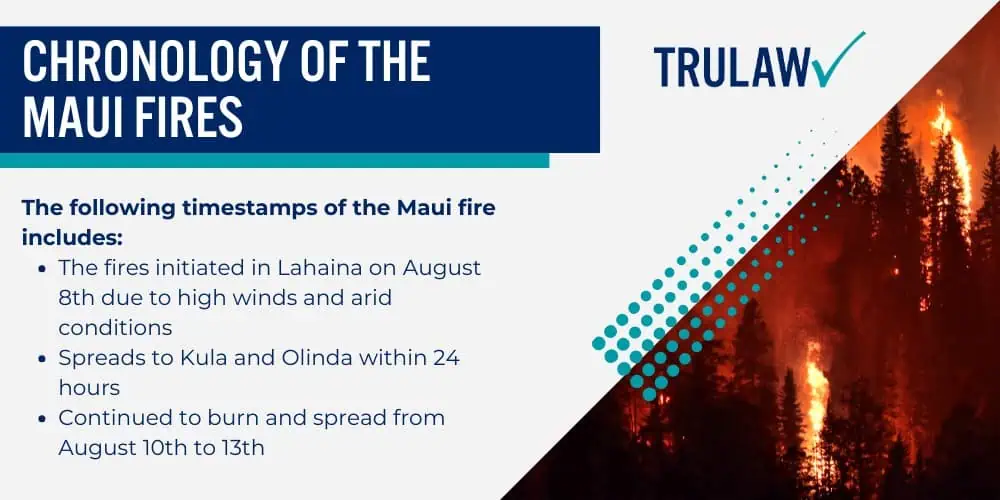
The following timestamps of the Maui fire includes:
- The fires initiated in Lahaina on August 8th due to high winds and arid conditions
- Spreads to Kula and Olinda within 24 hours
- Continued to burn and spread from August 10th to 13th
After the fires were brought under control, Maui County filed a lawsuit against the Hawaiian Electric Company for failing to shut off power in hazardous conditions
This lawsuit advances the legal precedent that utility companies must take appropriate precautions during potential fire-risk conditions to prevent or mitigate such calamities.
The outcome of this case may have significant ramifications for how such situations are handled in the future.
The Triggering Factor of the Maui Fires
In any legal analysis concerning a devastating event such as a fire, a pivotal point for investigation often pivots around a single concept known as the “triggering factor.”
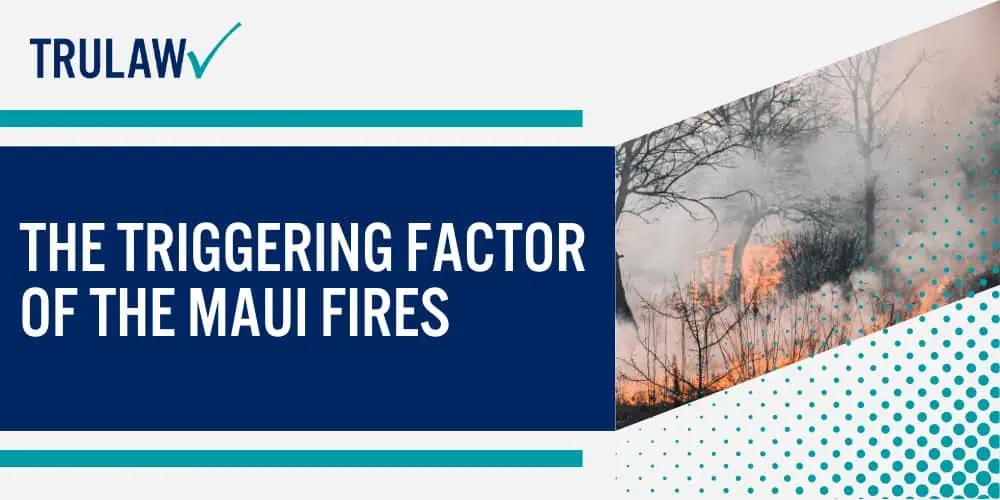
It is pivotal because it gets to the heart of liability: Who, or what, caused the incident to happen in the first place?
In this case, we must ask ourselves, what could have triggered the fire?
Act of God Vs. Human Negligence
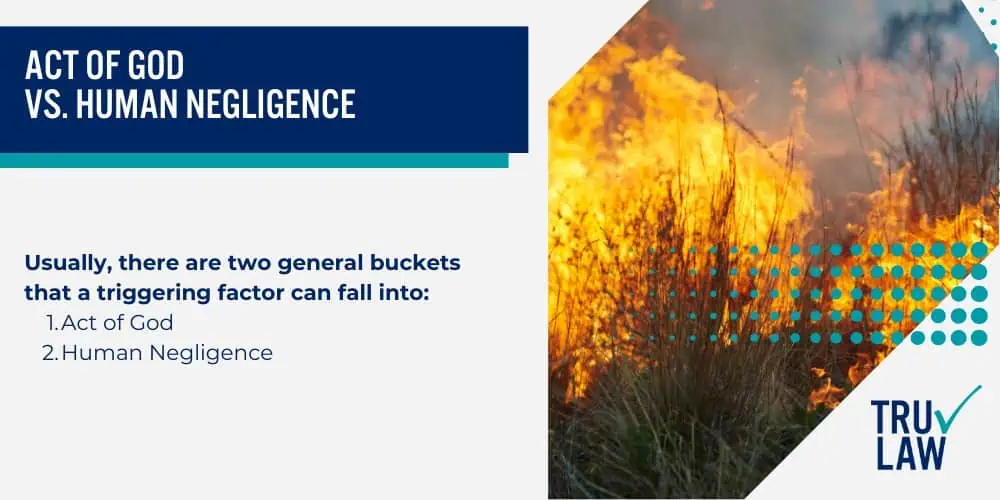
Usually, there are two general buckets that a triggering factor can fall into:
- Act of God: This is a natural event (like a storm or earthquake), which is beyond human control. No entity can be held responsible for an act of God. If it was a lightning strike or a sudden weather change that triggered the fire, no one holds legal liability.
- Human Negligence: Here is where things become legally intricate. If the fire was ignited due to someone’s negligent behavior, that individual or entity can be held liable.
Weather can serve as an independent triggering factor, or it can exacerbate existing hazardous conditions created by human negligence.
For example, a strong wind can spread an unattended fire very quickly, turning a bad situation into a catastrophic one.
However, a further investigation would be needed to draw a firm conclusion.
Role of Company Policy
Company policies and procedures in place to prevent fires or mitigate their impact can influence the determination of liability.
If the company had sound policies but those were not followed, ensuing damages could potentially be attributed to negligent employees.
If those employees were inadequately trained on the policies, this could constitute negligence on the company’s part.
Lastly, if the company had no policy in place, or a poorly designed one, it could be seen as demonstrating a lack of due diligence.
Proving the Triggering Factor
Proving the triggering factor is a critical part of any legal investigation.
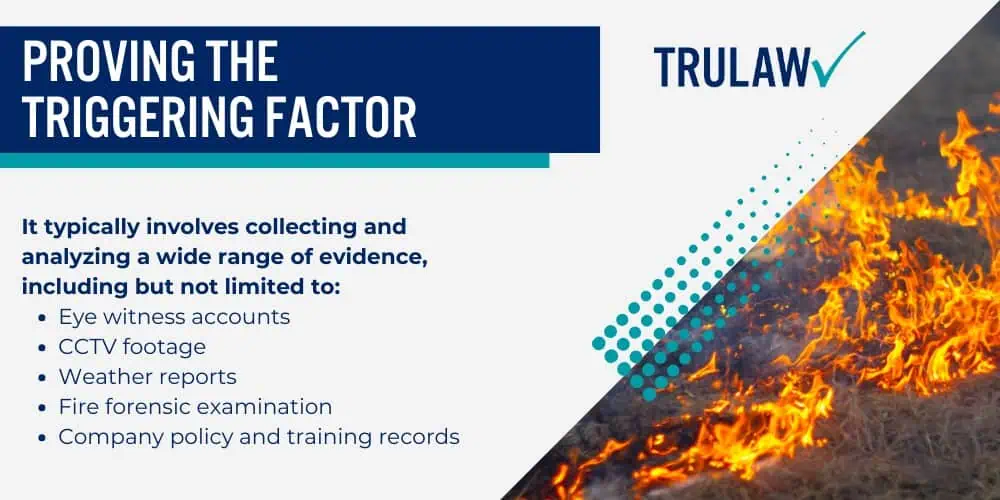
It typically involves collecting and analyzing a wide range of evidence, including but not limited to:
- Eye witness accounts
- CCTV footage
- Weather reports
- Fire forensic examination
- Company policy and training records
In conclusion, the triggering factor—whether weather, human negligence, or a combination thereof—will largely influence how legal liabilities are determined in this case.
Understanding this concept is critical for anyone seeking to navigate the complexities of legal situations involving catastrophic events like fires.
Maui Fires: Legal Actions Post-Fire
Once the flames have been extinguished and the immediate damage has been assessed, there is a crucial period during which accurate and stringent legal steps must be taken.
These steps are governed by national guidelines dictating the appropriate handling and preservation of evidence following a wildfire event.
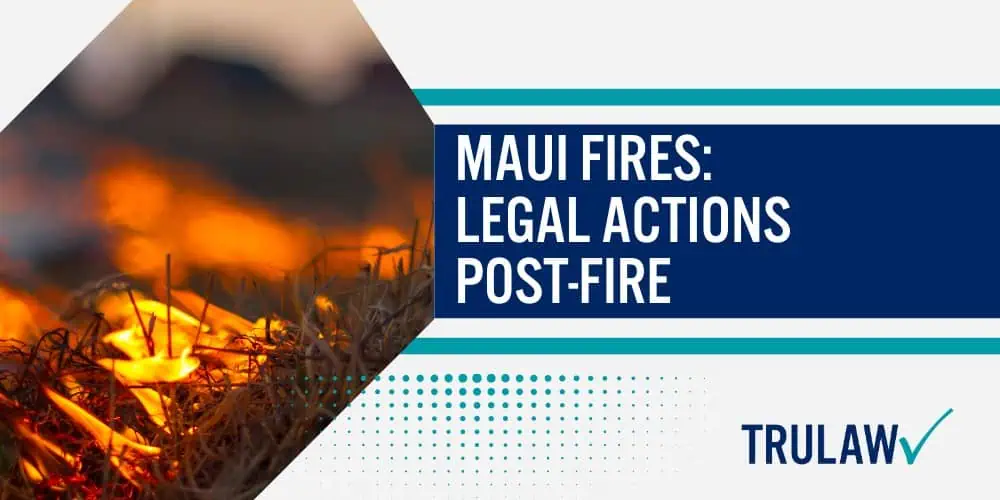
This section will explore the potential legal consequences, the utility company may face post-fire for possible violations of these guidelines.
Legal Probe Into Handling of Evidence
Government agencies’ interest in a utility company’s actions post-wildfire should be taken with grave seriousness.
These agencies have signaled that they are considering actions related to some 2020 wildfires.
Failure to maintain and protect evidence after a fire can have significant legal implications.
The opportunity to view any poles or downed lines in an undisturbed condition, both before and after the fire, is critical for investigators.
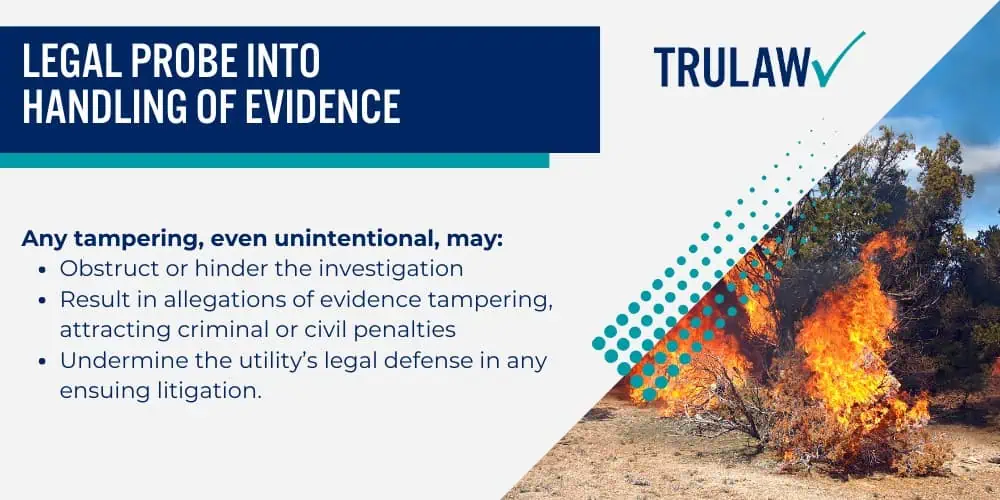
Any tampering, even unintentional, may:
- Obstruct or hinder the investigation
- Result in allegations of evidence tampering, attracting criminal or civil penalties
- Undermine the utility’s legal defense in any ensuing litigation.
Potential Violations of National Guidelines
National guidelines exist that provide clear instructions on how utilities should handle and preserve evidence in the aftermath of a wildfire.
These guidelines strive for the protection of valuable data that may shed light on the cause and progression of a wildfire.
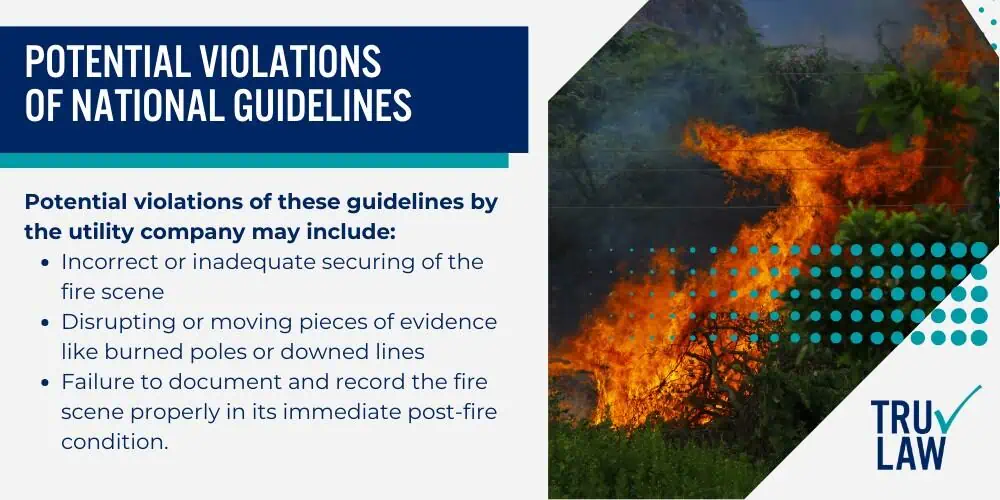
Potential violations of these guidelines by the utility company may include:
- Incorrect or inadequate securing of the fire scene
- Disrupting or moving pieces of evidence like burned poles or downed lines
- Failure to document and record the fire scene properly in its immediate post-fire condition.
Non-compliance with these guidelines may lead to serious legal consequences, including fines, lawsuits, or even criminal prosecution.
Potential Loss of Property
One of the ways this could materialize is through the devaluation of property due to the damage caused by the fire.
Furthermore, if the negligence or violations of the utility company resulted in enhanced wildfire damage, the impacted parties might have solid grounds to sue for compensation.
This could translate into substantial financial liabilities for the company.
Implication for Stakeholders
The utility’s stakeholders, including investors, employees, and customers, will closely watch the unfolding legal actions.
The company’s latest financial filing revealing the potential legal actions could create uncertainty among the stakeholders and may negatively affect the company’s stock value and public perception.
Strict adherence to post-fire guidelines is crucial, not only to aid in the accurate determination of the fire’s cause and progression but also to limit potential legal and financial repercussions.
We will closely observe this scenario as it develops, highlighting the importance of best legal practices and compliance in the utility sector.
Maui Fires Prevention and Mitigation Measures
Ensuring the safety of the community, particularly in areas prone to frequent natural and man-made disasters, requires concerted effort and substantial investment.
Scott Aaronson, EEI’s Head of Security and Preparedness emphasizes that:
“Substantial investments in adaptation, hardening, and resilience are being made to help mitigate risk.”
These measures include various actions that can be taken to prevent hazards, reduce their impact or cope with their aftermath.
Adapting to Fires in Maui
In the context of disaster management, adaptation refers to the adjustments made in natural or human systems in response to actual or expected climatic stimuli or their effects, which moderate harm or exploit beneficial opportunities.
In the case of the Maui wildfires, this may involve:
- Developing and implementing advanced technologies to predict and monitor climatic changes.
- Strengthening infrastructure to withstand adverse weather conditions.
- Implementing stringent regulations for construction and land use in vulnerable areas.
Hardening Infrastructure of Maui
Hardening is the process of fortifying infrastructure and buildings to withstand the impacts of severe weather and climate events.
The hardening process of the fires in Maui may include:
- Reinforcing structures to resist wind and water damage.
- Building or renovating structures to be more resistant to earthquakes and floods.
- Protecting electrical and communication systems.
Resilience: County of Maui
Resilience refers to the ability to recover quickly from difficulties.
In this context, resilience measures include:
- Incorporating disaster risk reduction strategies into mainstream city development plans.
- Establishing effective disaster response mechanisms.
- Developing social safety nets and insurance schemes for the affected population.
Prevention, on the other hand, focuses on reducing the risk of disaster by managing the causes.
It’s worth noting that utility companies have an essential role to play in this respect.
They have a responsibility to properly maintain and repair equipment, and also to trim vegetation — thus preventing contact that might otherwise cause spark-driven fires.
Mitigation measures refer to those policies and actions that are implemented to reduce the severity of the disaster’s impacts.
These mitigation measures may include:
- Construction of disaster-resistant and adaptive infrastructures.
- Implementation of early warning systems.
- Evacuation planning and drills.
- Public education programs about disaster risks and responses.
Lastly, in the immediate aftermath of a disaster, measures must be taken to protect individuals returning to their properties.
The usage of Personal Protective Equipment (PPE) is highly recommended in such situations.
The disaster prevention and mitigation are multifaceted and require a committed, integrated approach involving individuals, communities, organizations, and government agencies.
Through consistent adaptation, hardening, and resilience building measures, it is possible to create safer communities.
Reflecting On The Maui Fires
There’s a critical need for companies to enact a proactive approach when handling incidents such as fires or other catastrophic events.
A cohesive plan, if implemented effectively, can mitigate potential litigation risks, preserve evidence, and ensure proper protocol is followed throughout such events.
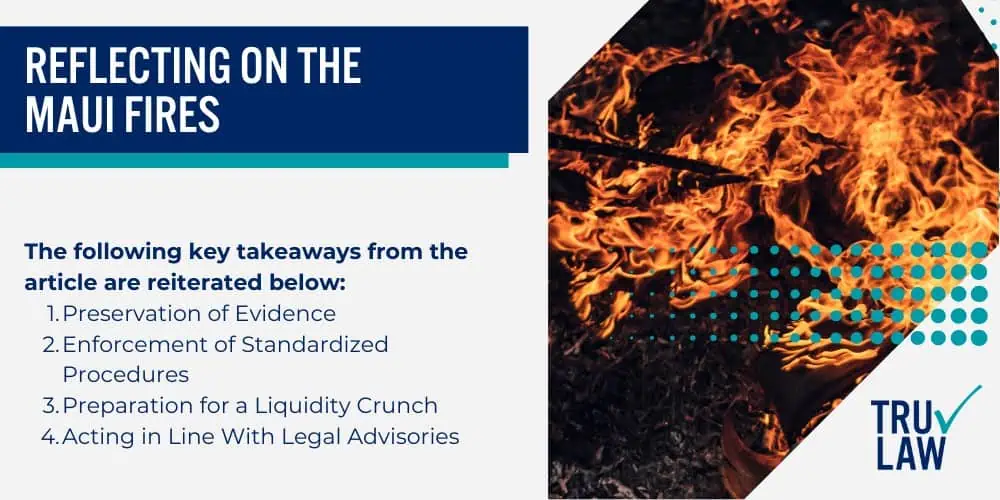
The following key takeaways from the article are reiterated below:
- Preservation of Evidence: The responsibility of preserving evidence falls heavily on the company, especially when incidents have occurred on company property. It’s crucial that the company acts swiftly, documenting the incident thoroughly while maintaining the integrity of the scene. Mishandling or alteration of evidence can lead to detrimental outcomes in future litigations and can also impede the company’s credibility.
- Enforcement of Standardized Procedures: Compliant handling of such incidents is not a mere suggestion, but a compulsory requirement. Companies need to enforce standardized procedures to manage the incident scene post-fire. This not only covers the responsibility of reporting to the authorities but also extends to how employees and other stakeholders should react in the aftermath.
- Preparation for a Liquidity Crunch: All businesses need to be prepared for the possibility of financial stress or a liquidity crunch following significant events like a fire. This involves having a financial contingency plan in place, including adequate insurance coverage, to take care of damage costs, litigation expenses, and operations disruption.
- Acting in Line With Legal Advisories: Companies need to engage with legal advisors early and throughout any incident. Legal experts will provide guidance on preserving evidence, compliance, and potential liabilities. The role of legal teams is significant in such scenarios as they provide the necessary legal perspective, helping the company navigate the complex legal landscape that such incidents often generate.
In conclusion, companies need to adopt a comprehensive and proactive approach to handle incidents like the fire discussed in this article.
However, the effectiveness of their response is significantly determined by their preparedness, procedural compliance, and adherence to legal advisories.
Therefore, it’s essential for businesses to recognize the importance of these factors, invest in educating their employees, and insure themselves adequately to mitigate the risks associated with such unfortunate incidents, ensuring they are well-prepared for any potential legal or financial repercussions.
Also, it’s worth noting that the company’s conduct post-incident will reflect on their public image and consumer trust.
Hence, the handling of such incidents not only has legal and financial implications but also significant reputational stakes.
Companies need to ensure their conduct in such situations aligns with their values and projects a sense of responsibility and integrity.
Maui Fire Lawsuit Frequently Asked Questions
-
The Maui wildfires, also referred to as the Hawaii wildfires of 2023, began on August 8th, 2023.
These devastating fires primarily affected parts of the island of Maui in the U.S. state of Hawaii.
The historic resort town of Lahaina, located on Maui’s western peninsula, was among the hardest-hit areas.
Impact of the Maui Fires
The Maui wildfires resulted in significant devastation, with many structures, including homes, businesses, and cultural centers, being destroyed.
In Lahaina alone, approximately 115 people lost their lives due to the smoke, flames, or by drowning, making this wildfire one of the deadliest on record globally.
Reports indicate that almost 3,000 structures were either damaged or completely destroyed by the fire.
In addition to the fires on Maui, other less severe wildfires also ignited parts of the island of Hawaii starting on August 9th.
-
The wildfires that ravaged Maui in 2023 have left many questioning their origins.
While pinpointing an exact cause remains elusive, there are several factors that experts believe contributed to the ignition and rapid spread of the Maui fires.
Potential Trigger: Downed Power Lines
Evidence has emerged suggesting that downed power lines could have been a significant trigger for the fires.
Such incidents are not uncommon, especially in areas with strong winds, and can lead to sparks that ignite dry vegetation.
Environmental Conditions
- High Winds: The days leading up to the fires experienced particularly strong winds. These winds not only have the potential to bring down power lines but can also rapidly spread flames once a fire has ignited.
- Drought Conditions: Maui, like many other regions, was grappling with drought conditions. Dry soil and vegetation provide the perfect fuel for wildfires, allowing them to spread quickly and burn more intensely.
Its possible that the main factors leading to the ignition of the Maui fires was a combination of environmental factors, potential triggers like downed power lines, and the presence of high winds.
-
Yes, Maui County filed a lawsuit against the Hawaiian Electric Company (HECO) and its subsidiaries.
The lawsuit alleges that HECO’s negligence caused the devastating wildfires.
The county of Maui accuses HECO of not properly maintaining the electrical system and power grid and failing to power down their systems under dangerous conditions
-
The government utilized various alert systems to warn residents of the impending danger.
These systems comprised of:
- The Wireless Emergency Alert system, which sends messages to people’s phones. However, many residents reported not receiving these alerts due to high winds, power outages, and damage to the cell service network.
- Siren Networks in some cities, like Mill Valley, California, which have installed new siren networks that can also broadcast voice messages. These systems can provide specific alerts for different threats.
Vegetation Management
One of the significant challenges was the presence of dry, invasive grasses, especially in areas like Lahaina.
Efforts in this area included:
- Educating communities about trimming vegetation around homes. However, mandatory rules compelling homeowners to do so were lacking.
- Recommendations for managing invasive grasses, creating defensible spaces, and working with private landowners to establish fire breaks. However, funding and implementation challenges hindered these projects.
To conclude, while the Maui wildfires were a tragic event, they have spurred a renewed focus on prevention, preparedness, and community engagement.
The lessons learned from this disaster will hopefully lead to more robust measures and policies to protect the residents of Maui and other vulnerable regions.

Managing Attorney & Owner
With over 25 years of legal experience, Jessica Paluch-Hoerman is an Illinois lawyer, a CPA, and a mother of three. She spent the first decade of her career working as an international tax attorney at Deloitte.
In 2009, Jessie co-founded her own law firm with her husband – which has scaled to over 30 employees since its conception.
In 2016, Jessie founded TruLaw, which allows her to collaborate with attorneys and legal experts across the United States on a daily basis. This hypervaluable network of experts is what enables her to share the most reliable, accurate, and up-to-date legal information with our readers!
Additional Maui Fire Lawsuit resources on our website:
Here, at TruLaw, we’re committed to helping victims get the justice they deserve.
Alongside our partner law firms, we have successfully collected over $3 Billion in verdicts and settlements on behalf of injured individuals.
Would you like our help?
At TruLaw, we fiercely combat corporations that endanger individuals’ well-being. If you’ve suffered injuries and believe these well-funded entities should be held accountable, we’re here for you.
With TruLaw, you gain access to successful and seasoned lawyers who maximize your chances of success. Our lawyers invest in you—they do not receive a dime until your lawsuit reaches a successful resolution!
AFFF Lawsuit claims are being filed against manufacturers of aqueous film-forming foam (AFFF), commonly used in firefighting.
Claims allege that companies such as 3M, DuPont, and Tyco Fire Products failed to adequately warn users about the potential dangers of AFFF exposure — including increased risks of various cancers and diseases.
Depo Provera Lawsuit claims are being filed by individuals who allege they developed meningioma (a type of brain tumor) after receiving Depo-Provera birth control injections.
A 2024 study found that women using Depo-Provera for at least 1 year are five times more likely to develop meningioma brain tumors compared to those not using the drug.
Suboxone Tooth Decay Lawsuit claims are being filed against Indivior, the manufacturer of Suboxone, a medication used to treat opioid addiction.
Claims allege that Indivior failed to adequately warn users about the potential dangers of severe tooth decay and dental injuries associated with Suboxone’s sublingual film version.
Social Media Harm Lawsuits are being filed against social media companies for allegedly causing mental health issues in children and teens.
Claims allege that companies like Meta, Google, ByteDance, and Snap designed addictive platforms that led to anxiety, depression, and other mental health issues without adequately warning users or parents.
Transvaginal Mesh Lawsuits are being filed against manufacturers of transvaginal mesh products used to treat pelvic organ prolapse (POP) and stress urinary incontinence (SUI).
Claims allege that companies like Ethicon, C.R. Bard, and Boston Scientific failed to adequately warn about potential dangers — including erosion, pain, and infection.
Bair Hugger Warming Blanket Lawsuits involve claims against 3M — alleging their surgical warming blankets caused severe infections and complications (particularly in hip and knee replacement surgeries).
Plaintiffs claim 3M failed to warn about potential risks — despite knowing about increased risk of deep joint infections since 2011.
Baby Formula NEC Lawsuit claims are being filed against manufacturers of cow’s milk-based baby formula products.
Claims allege that companies like Abbott Laboratories (Similac) and Mead Johnson & Company (Enfamil) failed to warn about the increased risk of necrotizing enterocolitis (NEC) in premature infants.
Here, at TruLaw, we’re committed to helping victims get the justice they deserve.
Alongside our partner law firms, we have successfully collected over $3 Billion in verdicts and settlements on behalf of injured individuals.
Would you like our help?
